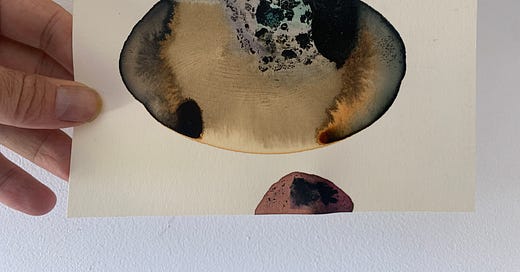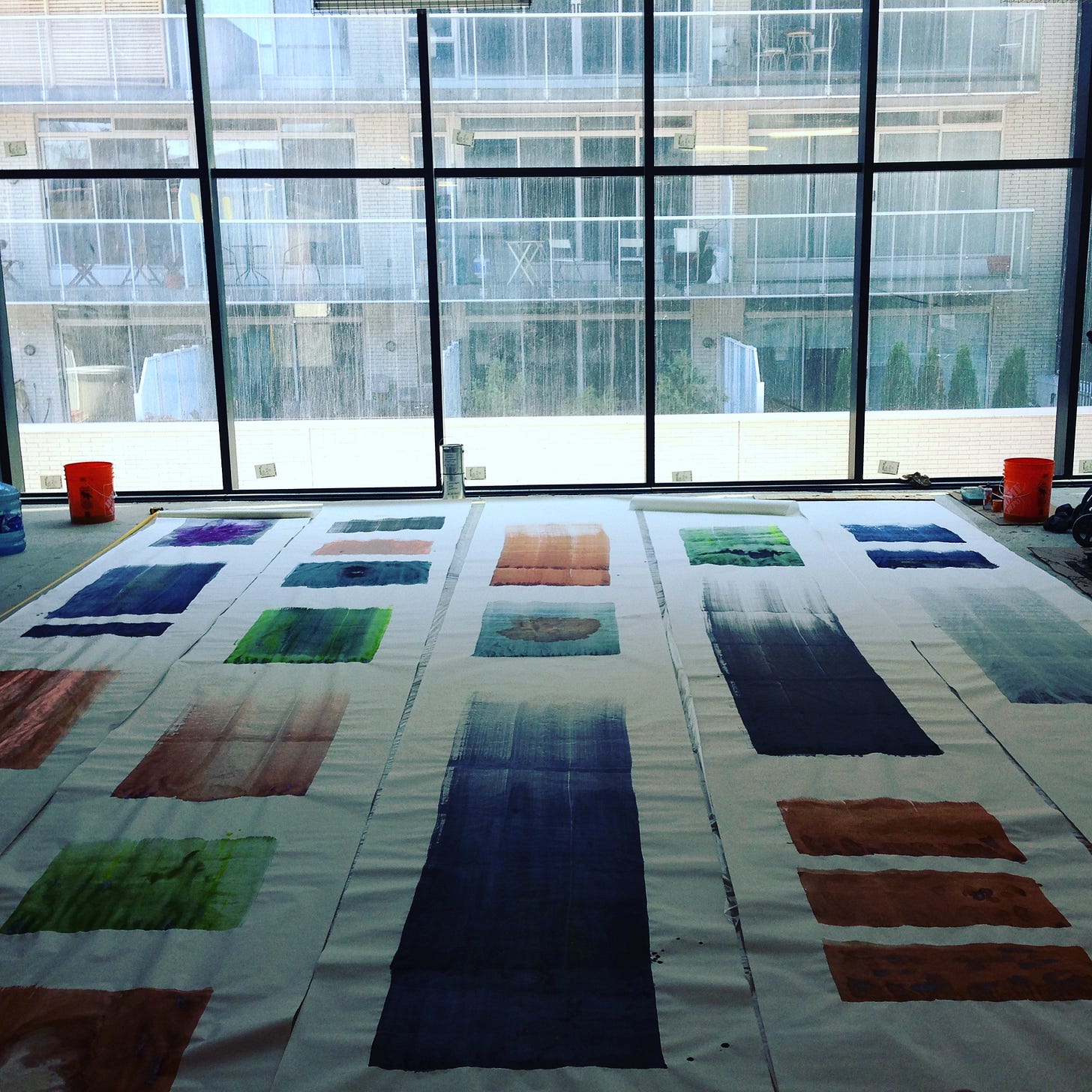I was going through old files the other day and I found this scrap of paper. It’s kind of a postcard-sized cut from a big sheet of Stonehenge paper as an inktest. I didn’t label it but I can still see rust and copper oxide and soot, and what looks like maybe wild grape skin mash. It’s probably 3 or 4 years old, and definitely fading but it still has a bit of colour and texture in it.
I was actually about to recycle the scrap along with some other long-ago ink tests but then I stopped because it looked kind of familiar and looking closer I realized, of course, that it was the ink test I had taken a photo of while still wet years ago and put onto Instagram which then became the background of the poster for the release of The Colour of Ink. By now you probably know about this documentary made by Brian D. Johnson for the National Film Board of Canada and Sphinx Productions with the incredible camera-eye of Nick de Pencier— a project that I have been immersed in since forever, which is now about to have its international debut at the Toronto International Film Festival. The little scrap of paper looks huge, like a whole world in the poster, and there I am with my back to the audience heroically looking towards this ink blob like some discoverer of a new planet. I love this poster and I’ve made my peace with being the David Attenborough figure of the documentary if it helps create a focal point for the colour revolution that I have been so invested in. But the image, as well as it works misses something. Maybe it’s too fine a point for promotion but the film is not really a portrait of an artist’s story, but a portrait of the network of incredible colour workers from around the world. You will meet a futuristic traditional Islamic calligrapher in London, a New Yorker cartoonist in Brooklyn, an indigenous woodcarver in BC, an ochre-speaker in Washington State and an artist experimenter in an ancient marble quarry in Italy. All of these characters, and others, were drawn into this film of place-based colour, and really, if there is a heroic quest it is the quest of the ink itself, and in my mind the people (as thrilling as they are all to meet) are a kind of chorus for the colours themselves.
For my own work, the payoff has never been a work of art on paper but rather the behind the scenes adventures of perfecting recipes, distilling landscapes, leading and learning in workshops, and the part where I send out inks and get to see them do their thing in the hands of master calligraphers and storytellers, artists and cartoonists that I admire. It’s weird to see both me and that ink test so epically proportioned because I’ve been so focused on the tiny details. And, I was about to say, that I’ve always worked small, but that’s not exactly true.
Some years ago I was working on a project for a big hotel who wanted to cover a huge stairwell wall with large inktests. As usual I said sure, and then I got nervous about how to actually pull this off. I talked to my friend Brent who was the only person I could think of that works in large sizes, and he mentioned this essay by Italo Calvino about lightness which describes the sometimes weighty heroism of lightness. Starting with a flying Perseus, Calvino (as described by Brent) suggests that defying the ballast of the world is in a way the artist’s job. Everything is so heavy Brent said, the really beautiful stuff, the stuff that people value makes us forget all the things that drag us down if only for a moment. He thought a giant inktest on a wall would be best if it looked impossibly easy, and even better if it could somehow embody a gravity-defying grace. Which turned out to be pretty much impossible. Even with an amazing wallpaper specialist, some of the world’s strongest, thinnest Japanese mulberry papers, a vat of copper chop (a whole other story), various obscure berry juices, binders and brick dust, and a whole team of people setting up a scaffolding for me to kind of hang off of (totally dangerous, will never do this again), gravity is gravity and ink is ink and liquids want to drip rather than pool in a vertical world. The job was the opposite of light and easy. There was a terrifying skinhead contractor boss who made me scrape off all of the beautiful Japanese paper and rice glue and start over again. There was a kind of night clubby guy named Rizzo who ran a bunch of properties and let me into the rooftop pool at night and was always friendly until he wasn’t. There was a mastermind out of New York who seemed to be about 12 years old, always on vacation and who caused a cascade of problems. There was also a triple paintbrush that my friend Don invented for me. There were many long days and sleepless nights, and a general feeling that this job would never be done, and finally, a somewhat compromised end result and (maybe most importantly) a promise to myself that I would never try to go big again.


But then last week, around the time that I learned that the film had been accepted into TIFF, I found myself at the new Ace Hotel dropping off some large 40 x 33” artworks for the rooms there, and kind of loving their size. I also dropped off 100 postcards made with Toronto street-scavenged colour. And I loved their size too. So maybe there is something to be said for the relationship between the small and the large. Or is there a lesson about balance that I am still trying to learn? I’d love to hear what you think. —JL
Tonight in the members-only Colour Lab, I have included some of my discoveries about using ink on a large scale. I hope you will consider joining as a paid member for just $7 a month which goes 100 percent to helping this newsletter keep going. But first a poem:
My Life Was the Size of My Life
My life was the size of my life.
Its rooms were room-sized,
its soul was the size of a soul.
In its background, mitochondria hummed,
above it sun, clouds, snow,
the transit of stars and planets.
It rode elevators, bullet trains,
various airplanes, a donkey.
It wore socks, shirts, its own ears and nose.
It ate, it slept, it opened
and closed its hands, its windows.
Others, I know, had lives larger.
Others, I know, had lives shorter.
The depth of lives, too, is different.
There were times my life and I made jokes together.
There were times we made bread.
Once, I grew moody and distant.
I told my life I would like some time,
I would like to try seeing others.
In a week, my empty suitcase and I returned.
I was hungry, then, and my life,
my life, too, was hungry, we could not keep
our hands off our clothes on
our tongues from
Keep reading with a 7-day free trial
Subscribe to The Colour | Newsletter | Lab | Community to keep reading this post and get 7 days of free access to the full post archives.







